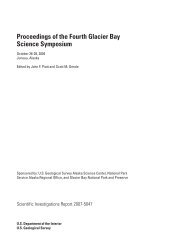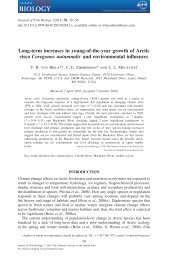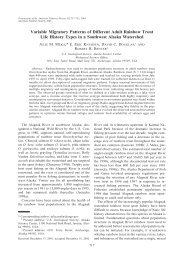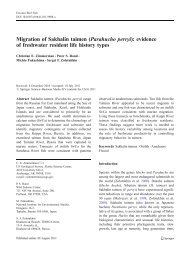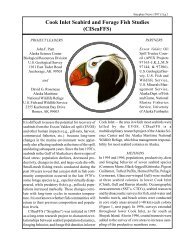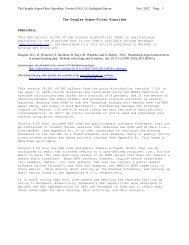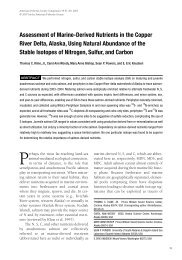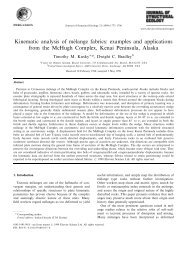Mexican native trouts: a review of their history and ... - Webspace
Mexican native trouts: a review of their history and ... - Webspace
Mexican native trouts: a review of their history and ... - Webspace
You also want an ePaper? Increase the reach of your titles
YUMPU automatically turns print PDFs into web optimized ePapers that Google loves.
308<br />
wild habitats. We apparently have found areas where<br />
introgression <strong>of</strong> <strong>native</strong> <strong>and</strong> non-<strong>native</strong> gene pools<br />
is advanced, though substantiation <strong>of</strong> that requires<br />
additional analyses. In other areas, we have not yet<br />
detected indications <strong>of</strong> hybridization, but our sampling<br />
to date is likely inadequate for elucidation <strong>of</strong> this<br />
possibility. There is little doubt in our minds that<br />
future sampling will reveal more <strong>and</strong> more widely<br />
distributed occurrences <strong>of</strong> introgression <strong>of</strong> rainbow<br />
<strong>and</strong> <strong>native</strong> gene pools. The extent <strong>of</strong> the area involved,<br />
its general topographic complexity, <strong>and</strong> the (even<br />
now) remoteness <strong>of</strong> many <strong>of</strong> its headwater tributaries,<br />
should help assure that small, isolated <strong>native</strong> populations<br />
will remain unexposed to non-<strong>native</strong> stocks in<br />
the near future, but we feel it is important to quickly<br />
discover <strong>and</strong> protect those populations before they<br />
become contaminated.<br />
In this contribution we have concentrated on real<br />
or potential problems created by introductions <strong>of</strong> non<strong>native</strong><br />
<strong>trouts</strong>, but other non-<strong>native</strong> fishes also have<br />
<strong>their</strong> potential impacts on the system. Our collections<br />
<strong>and</strong> those <strong>of</strong> others have documented the presence <strong>of</strong><br />
several species <strong>of</strong> exotic centrarchids <strong>and</strong> ictalurids<br />
within the general range <strong>of</strong> <strong>native</strong> <strong>Mexican</strong> <strong>trouts</strong>.<br />
Largemouth bass surely will feed on trout if given<br />
the opportunity, as might large catfishes, <strong>and</strong> smaller<br />
centrarchids likely compete with trout for food, as<br />
well as prey on fry <strong>and</strong> juveniles. Nonetheless, all<br />
<strong>of</strong> these exotics are being increasingly introduced<br />
into a surprising number <strong>of</strong> high-elevation, man-made<br />
ponds <strong>and</strong> (eventually) natural waterways which could<br />
harbor <strong>native</strong> <strong>trouts</strong>. Ways need to be found to limit<br />
or, at least, rigorously manage the continued introduction<br />
<strong>of</strong> species now being promoted by government<br />
agencies <strong>and</strong> others.<br />
Threats from logging, grazing <strong>and</strong> other agriculture<br />
Logging will continue to exp<strong>and</strong> in the region,<br />
although accelerated harvest has resulted in a shortfall<br />
<strong>of</strong> commercially-sized secondary growth. Pulpwood<br />
markets have recently promoted commercial exploitation<br />
<strong>of</strong> smaller material, including oak, <strong>and</strong> sawmills<br />
are still touted as value-added economic development.<br />
Supporting out anecdotal observations, Guerrero <strong>and</strong><br />
colleagues (Guerrero et al., 2001) reported that the<br />
number <strong>of</strong> registered sawmills in Chihuahua increased<br />
from 108 in 1993 to 309 in 1998. As it was in the<br />
1950s, sawdust waste entering watercourses is again<br />
a concern, along with leakage <strong>of</strong> associated oil-based<br />
pollutants into streams <strong>and</strong> groundwater.<br />
Forestry policies have changed numerous times<br />
over the past century through efforts to make Mexico<br />
more competitive <strong>and</strong> sustainable in the global forest<br />
products market. Evolving policies <strong>of</strong>ten <strong>of</strong>fer incentives<br />
that tend to increase pressure to cut more forest<br />
to make ends meet (Guerrero et al., 2001). A relatively<br />
new Agrarian Code now allows privatization <strong>of</strong><br />
parcels within ejidos (a community-based l<strong>and</strong> ownership<br />
system which has existed in one form or another<br />
for centuries, but instituted in its present format<br />
following the 1910 revolution) to attract capital <strong>and</strong><br />
promote efficient management. However, the socioeconomics<br />
<strong>of</strong> rural Mexico make changing forestry<br />
practices in the direction <strong>of</strong> habitat protection very<br />
difficult. Approximately seventy percent <strong>of</strong> forest<br />
l<strong>and</strong> in Chihuahua is under ejido ownership (Association<br />
<strong>of</strong> <strong>Mexican</strong> Pr<strong>of</strong>essional Foresters, 1996),<br />
<strong>and</strong> much <strong>of</strong> that includes <strong>native</strong> trout habitat. The<br />
complexity <strong>of</strong> negotiating conservation agreements<br />
with ejidos is illustrated by the experience <strong>of</strong> McDonnell<br />
<strong>and</strong> Vacariu (2000), who found it necessary<br />
to provide economic alter<strong>native</strong>s in order to reach<br />
an agreement protecting the most critical remaining<br />
nesting site <strong>of</strong> the endangered thick-billed parrot.<br />
Thoms <strong>and</strong> Betters (1998) outline four components<br />
favorable to implementing ecosystem management in<br />
ejidos: (1) communication <strong>and</strong> cooperation between<br />
numerous agencies; (2) diversifying the economy<br />
to reduce pressure to log; (3) environmental education<br />
<strong>and</strong> both short- <strong>and</strong> long-term planning; <strong>and</strong> (4)<br />
exp<strong>and</strong>ed administration capacity to address resources<br />
other than timber. García <strong>and</strong> collaborators (1994)<br />
surveyed residents <strong>of</strong> Ejido Largo Madera, one <strong>of</strong><br />
the larger <strong>and</strong> more successful ejidos in Chihuahua,<br />
extending from Madera, Chihuahua to the headwaters<br />
<strong>of</strong> the Río Gavilán. Their study exemplifies the<br />
importance <strong>of</strong> providing economic alter<strong>native</strong>s. Those<br />
they interviewed were keenly interested in economic<br />
diversification <strong>and</strong> fearful <strong>of</strong> over-reliance on traditional<br />
forestry practices, but lacked capital to try new<br />
initiatives. In such settings, government-financed initiatives,<br />
such as rainbow trout culture, can be popular.<br />
Even if agreements are reached that appear sustainable,<br />
illegal practices can remain a concern despite<br />
proper changes in forestry laws <strong>and</strong> l<strong>and</strong> management.<br />
Barry (1994) indicates that environmental laws<br />
in Mexico can <strong>of</strong>ten be more stringent than in the<br />
U.S., but enforcement is almost always problematic<br />
(Guerrero et al., 2001; Klooster, 1999). Regardless <strong>of</strong><br />
such concerns, progress is being made in some areas.<br />
Aguirre-Bravo <strong>and</strong> Reich (1998) promoted an inte-




